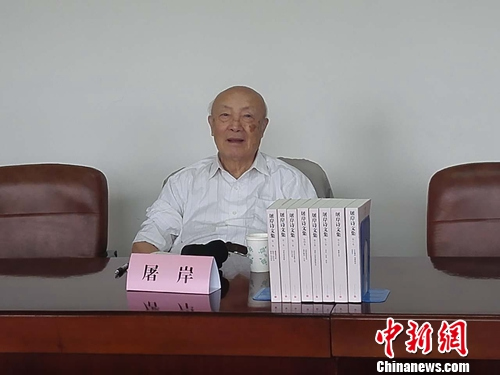黄友义:促进语言服务行业创新 共建亚太地区翻译的明天
本文为中国翻译协会常务副会长黄友义在第八届亚太翻译论坛上的讲话。
6月18日,中国翻译协会常务副会长黄友义在第八届亚太翻译论坛上讲话。
[中国网 陈博渊 摄]
促进语言服务行业创新 共建亚太地区翻译的明天
——在第八届亚太翻译论坛上的讲话
中国翻译协会常务副会长 黄友义
(2016年6月18日 西安)
各位来宾,
女士们、先生们:
大家下午好!这两天我们齐聚古城西安,一起探讨亚太翻译界面临的问题与挑战,提出对亚太地区翻译发展的诉求和期待,共谋亚太地区翻译文化与行业繁荣发展的明天。
翻译作为交流的桥梁,在国际文化文明交流互鉴中发挥越来越重要的作用。信息化和全球化的飞速发展不断赋予翻译工作新的内涵和外延,今天的语言服务业远远超出单纯的口译和笔译的范畴,已经拓展成为一个包括翻译服务、本地化服务、语言技术与工具研发、术语等语言资产管理、全球化与本地化咨询服务以及相关教育培训服务在内的新兴服务业。
在这一背景下,中国语言服务业呈现出持续快速增长的态势,初步形成了一个颇具可持续增长潜力的产业链。这种趋势直接得益于中国正在推进的“一带一路”构想。
早在2011年,中国翻译协会的一项调研表明,中译外的工作量第一次超过了外译中,而这种趋势近年更加突出。语言服务业在市场规模增长的同时,其市场需求也将发生显著的结构性变化,小语种的需求将增长,网站和多媒体服务需求将增长,内容产业的爆炸式发展对语言服务将产生大量新需求。面对各种发展态势和新的需求,语言服务行业也要开始积极探索新的能力与定位。中国翻译界连续两年举办高层研讨会,探讨如何给发展中的翻译业重新定义。
正如本届论坛上专家们在发言中所提到,语言服务在全球化的今天既有机遇也有挑战,中国语言服务企业的发展正面临全球化的考验,需要加强对翻译和语言服务工作的科学规划与标准化建设,顺应社会和市场的需求,促进行业有序发展。
作为一个新兴的行业,语言服务仍处于产业化发展的初级阶段,由于国内针对翻译和语言服务工作没有相关的方向性指导和整体行业发展规划,行业的标准化建设还不完善,国内语言服务市场缺乏有效的监督评估与管理机制,企业良莠不齐,社会与行业需求的高素质、职业化的翻译人才队伍依然严重缺乏。
近年来,业界人士对制定语言服务行业的整体规划和指导意见的呼声日益高涨,希望通过有序的行业规划以及建立相应的行业规范,提升行业整体竞争能力。
我们期待,语言服务产业的发展将越来越规范化,顺应社会和市场的需求,需要行业规划,需要标准规范,也需要如中国翻译协会这样的机构对语言服务市场的规范化管理发挥更大的作用。中国翻译协会正在开展行业调研,以期推进行业规划的制定与行业标准化建设工作,促进语言服务行业健康有序发展。
创新是行业发展不能回避的话题,全球语言服务的需求持续增长,服务领域不断拓展,服务内容日趋多元化,语言技术蓬勃发展,这对当前的语言服务行业发展提出了新的挑战。
语言服务业这些年来不乏创新:基于大数据技术的机器翻译、机器辅助翻译、语料库建设、本地化、云翻译等技术正成为变革语言服务模式的推动力,新的商业模式也不断出现并得到推广。这些技术和模式不一定都能成功,但它们指出了在大数据时代我们行业未来的发展方向。
语言服务企业以小微企业为主,创新能力不足,市场竞争环境亟待改善,高端翻译及其他从业人才严重匮乏,国内翻译人才培养与行业需求严重脱节,翻译研究与行业发展现状严重脱节,这些都制约着行业发展。
如何推动进一步创新,是摆在面前的一个课题。创新要以用户需求、市场为导向,必须建立在对整个产业链的深入了解和分析的基础上,找准定位。创新不仅是在技术上,在管理上同样需要创新。
此外,我们还要突破行业本身的局限,从全球化和信息化整体发展趋势中寻找方向。小而全的企业现在很难有市场,专业化是中小企业的发展方向,这就决定了我们必须相互协作,发挥各自的优势才能满足市场多元的需求,进行政产研各方面的协同创新。这包括语言服务企业与需求方的合作、语言服务企业之间的合作、语言服务企业与相关方,如政府相关部门和高等院校之间的合作等等。目前,已经出现由地方政府与企业主导的语言服务基地,由高校主导的协同创新中心、由企业主导的产业创新联盟等政产学研结合的机制,将生产企业、科研单位、高等院校结合成一个有机的整体,最大限度发挥各自优势,集科研、教育、开发、研制、生产、销售于一体,协同发展,这是一个令人十分振奋的现象。
作为行业协会,致力于汇聚业界相关资源,解决行业面临的共同问题,是中国翻译协会的责任所在。中国译协目前正致力于推动产学结合,例如和教指委合作的兼职教师和实习基地认证,全国范围的翻译专业师资的培养,推动翻译资格考试和人才培训等等,使翻译人才培养符合市场的需求。
从全球范围看,国际语言服务企业也在不断开拓更多的业务增长点,例如根据相关统计 ,美国语言服务企业的收入大多数来自医疗,法律和政府领域。相比之下,欧洲和其他地区语言服务企业的年收入比例最高的领域是分别是技术、制造和软件。
我想强调的是,各国翻译界在促进语言服务行业创新中也不乏值得我们借鉴的思路和举措,我们应该把技术写作、文档格式转换、语料对齐、翻译记忆、语音识别、自动化质量保证、翻译管理等工具广泛应用于产业翻译实践之中。
上述技术的蓬勃发展和行业应用,加快了翻译速度,优化了翻译流程,降低了翻译成本,提升了行业整体翻译生产效率,将成为语言服务模式变革的推动力。
作为中国翻译界唯一的全国性社会组织,中国译协一直将推进翻译事业与国家发展和社会进步紧密相连,积极推动语言服务的创新和进一步发展,在提升翻译工作水平、加强翻译队伍建设、促进翻译学术研究、规范翻译行业管理、推动翻译文化国际交流方面发挥着组织引导作用。协会通过发布行业发展报告、制定行业规范、倡议行业诚信、打造行业交流平台,呼吁并调研翻译立法等一系列务实举措,积极培育新兴语言服务业,为行业发展创造了良好的环境。积极创新人才培养机制,促进学术交流,加强翻译学科建设,进一步推动产学研融合。同时积极参与国际翻译文化交流,与国际组织开展务实合作。
女士们,先生们,各位同事,21年来,亚洲翻译论坛一直坚持初衷,从只有十几个国家代表出席的不足百人的第一届亚洲翻译家论坛发展成为亚太翻译界的聚会,为翻译界搭建一个开放性的交流机制和平台,探索翻译工作的规律和方法,为翻译界服务,为广大翻译工作者服务。
同欧洲和北美地区相比,我们亚太地区语言多,而翻译行业协会规模小,交流不多,行业不规范,更缺乏地区性翻译行业标准和发展规划。而这个地区又是经济发展最具活力的一个区域,对语言服务的需求既紧迫又多种多样。令人激动的是,经过多年筹备,我们这次论坛终于见证了亚太翻译论坛联合委员会。我希望亚太地区翻译界能够加强联系,吸引更多地参加区域性的研讨。
各位同仁,亚太地区翻译的明天离不开各位代表的支持和努力。我们愿意与各位一起努力,继续为语言服务的供需双方搭建高端、国际化、专业化的桥梁,让亚太地区的语言服务在贸易全球化中的基础性支撑作用得到更好的体现。
最后,再次感谢大家对本届论坛的大力支持!我们来到这里是为了分享和互相学习,在会后将继续开展业内外经验交流与务实合作!祝大家工作愉快、身体健康!
Huang Youyi: Build a Better Future for the Asia-Pacific Region through Innovations in the Language Service Industry
China.org.cn, June 20, 2016
Build a Better Future for the Asia-Pacific Region through Innovations in the Language Service Industry
Speech at the Eighth Asia-Pacific Translation and Interpreting Forum
Huang Youyi
Executive Vice President of the Translators Association of China
June 18, 2016
Distinguished guests:
Dear Colleagues:
Good afternoon. For the past two days, we have gathered here in this ancient city of Xi'an to discuss the challenges and opportunities that we translators in the Asia-Pacific region face, sharing our ideas and expectations, for the purpose bringing about a flourishing and beautiful tomorrow for the translation industry in our region.
As a bridge for communications, translation is assuming an increasingly important role in the exchanges of cultures and civilizations of the world. Speedy development in globalization and IT application has given translation new meaning and opened up new ground. Today, language service industry has way gone beyond traditional oral interpretation and written translation; in fact it has become an entirely new service industry that includes translation services, localization services, development of language technology and language tools, management of terminology, consultation in globalization and localization and related training and education.
Against this backdrop, China's language service industry has demonstrated a sustained growth and presented itself as a new industrial chain with great potentials. Much of this development is related to the Belt and Road Initiative that China is implementing.
While growing in scale, the Chinese language service market has shown some structural changes. One change is revealed by a study conducted in 2011 by the Translators Association of China which demonstrated that translation from Chinese into foreign languages for the first time exceeded the workload the other way round. Other changes include the demand for services in languages of very limited diffusion, expanding demand for website and multimedia services. Explosion of content has directly led to greater demand for language services.
In the face of industrial changes and new demands, people in the language service industry have begun explorations for new definitions. In the last two years, professionals in China have held two high-level seminars to discuss the changes and how best redefine the profession of translation.
As we have heard from the speeches people have made at this forum, global language services have presented us with both challenges and opportunities. In a way, China's language service industry faces the challenge brought about by globalized economy. This poses the need for well-designed planning and standardization so as to respond to market demand and better development of the industry.
As an emerging industrial sector, language services are still in their infancy stage. Since there are no domestic industrial guidance and plans for language service, there is very little effective supervision and regulation. Companies vary in performance and there is a dire shortage of highly qualified professionals for language services.
In recent years, people in this profession have called for overall planning and guidance in the hope of setting up some standards to raise competitiveness.
We would like to see that the development of language services can follow an increasingly standardized path. For our society and our market, there is a need for industrial planning, and standards. And in this process the Translators Association of China (TAC) is expected to play a big role. Right now, TAC is conducting studies in the hope of pushing forward industrial standardization so as to ensure healthy and orderly development.
Innovation is an unavoidable topic these days when we talk about industrial growth. Market demand for language services around the globe has been on the rise, areas covered by our services keep expanding, and technology for language services progresses with each passing day. All of this has posted new challenges to the development of language services.
Indeed innovation in language services has never been short in the past: machine translation based on big data, computer-aided translation, corpus development, localization, and cloud computing have become new propellers and new commercial modes have also merged. Though there is no guarantee that all the new technologies and commercial experiments may succeed in the end, they nevertheless have pinpointed the direction of our profession in the future characterized by big data.
In languages services, most service providers are micro and small companies who are weak in innovation and the environment for market competition has much to improve. High-end professionals are in short supply; Training of professionals cannot meet the market demand. Often there is little relationship between translation research and professional development reality. All of this imposes constraints on the development of our profession and our services.
That how to boost innovation remains a problem we have to tackle. Innovation should be guided by cliental needs and market demand. It must be conducted on the basis of thorough analysis of the entire industrial chain. Innovation does not only mean technology. Innovation is also needed in management of language services.
Besides, we must also break away from the limitations of our own profession and try to find the right direction in the development trend of globalization and IT application. Enterprises that are small and yet try to do everything will find it very difficult to operate in the market. Specialization should be the way of progress.
This has determined that we must cooperate through concerted efforts from the government, industry and researchers, giving play to our own specific advantages in responding to diversified market demand. This kind of cooperation should be conducted between language service providers and the clients, among language service providers themselves, between language service providers and other stakeholders such as the government, universities and research institutes.
We have seen the rise of language service centers operated by local government agencies together with enterprises, innovation centers run by universities, as well as alliance established between enterprises with government, universities and service providers. They bring all sectors engaged in production, research and education into an organic whole with each side demonstrating its unique strength. It is very exciting to see cooperative efforts coming from all sources including scientific research, education, technological development, production and sales.
As a professional and industrial association, TAC regards its duty to draw resources from all sectors concerned in order to find solutions to the problems we face. It is currently engaged in bringing universities to work together with professional employers. Some of the projects we have been doing include the selection and accreditation of teachers from among translation practitioners and the identification of companies where students can work as interns, training programs for young teachers in translation and interpretation together with the National Committee for MTI Education, promotion of professional accreditation tests and professional training sessions. We hope that through what we do, we can help satisfy the market need for professionals in language services.
Globally, there have been many new drivers of growth for the international language service industry. According to the 2015 Industry Survey made by the Association of Language Companies, income for US language service providers mostly came from health, legal and government services while in Europe and other regions, technology, manufacture and software were the top income sources.
What I want to emphasize here is that there are many good practices by translators in other countries we in China can learn and benefit from. We need to extensively apply to our practice such tools as technical writing, translation format conversion, corpora alignment, translation memory, voice recognition, automatic translation quality assurance and translation project management.
The development and application of these technologies have quickened and optimized the process of translation, reduced translation cost and enhanced industrial production efficiency, further transforming language services.
As the only national organization in translation, TAC has been active in encouraging and working in language service development and innovation, raising translation level, building up the rank of translation professionals, promoting translation research and studies, standardizing translation management and enhancing international exchange in translation.
Through such means as publicizing industrial development reports, drawing up trade regulations and standards, calling for maintaining professional discipline and credibility, setting up platforms of professional exchanges, undertaking investigation into and proposing legislation in translation, our association aims to cultivate a new language service industry and create a favorable environment for industrial growth. We have been working hard to innovate ways for professional training and conducting academic exchanges, strengthening translation discipline and encouraging further integration of industry, education and research. Meanwhile, we have also maintained cooperation with translation professionals and associations from other countries.
Ladies and gentlemen, dear colleagues, 21 years have gone by since we held in Beijing the First Asia Translators Forum attended by about 100 participants from over a dozen countries. Now we have a grand gathering of translation professionals through the Asia and Pacific region. It has become a platform for open discussions where we explore the rules and methods in translation, in order to better serve the translation industry and all translators and interpreters.
Compared with Europe and America, we, in Asia and Pacific, speak more languages, but our associations tend to be small and weak, we have less exchange schemes and there are no regional professional planning and standards to speak of. But this is a region where the economy is most dynamic and the need for language services is more urgent and diversified. After years of preparation, at this forum, we finally saw the establishment of the Joint Committee of the APTIF. I hope more and more translation professionals in our region will be able to establish contact and take part in exchanges.
Dear colleagues, translation in tomorrow's Asia and Pacific cannot exist without the participation and support of all the people present here. We wish to work together with all of you to build a high-end, internationally standard and highly professional language service bridge linking up practitioners and those who need their services. Together we can make language service a stronger pillar for Asia and Pacific in the global service trade.
To conclude, I want to thank all the participants for your support. We came here to share and learn, and now we leave with the resolve to continue our exchanges and cooperation in the future. I wish you all the best!
Thank you all.






![[LoliHouse] Princess-Session Orchestra - 15 [WebRip 1080p HEVC-10bit...](http://s2.loli.net/2025/04/09/QO618K72ytGZmDJ.webp)







